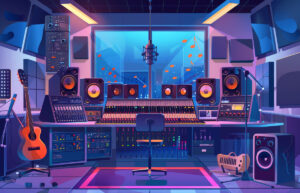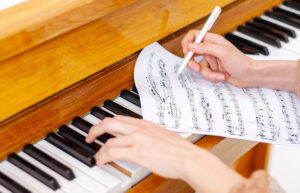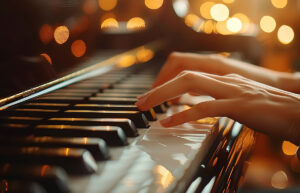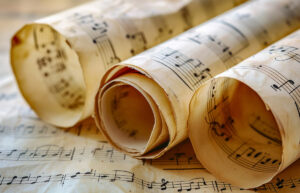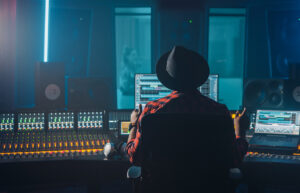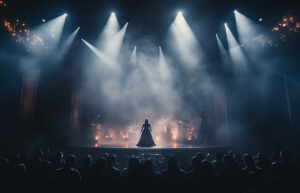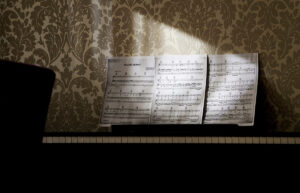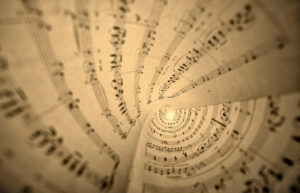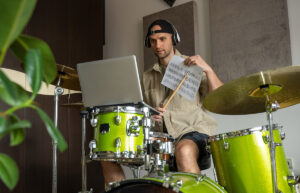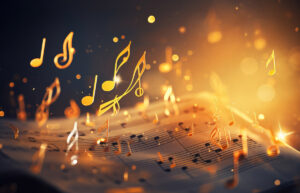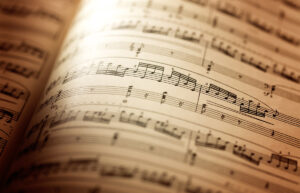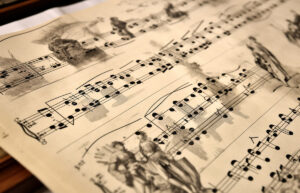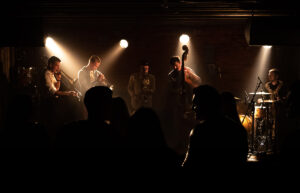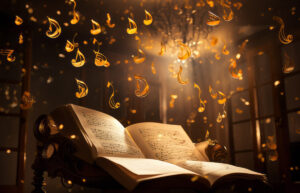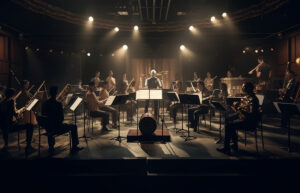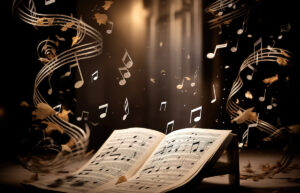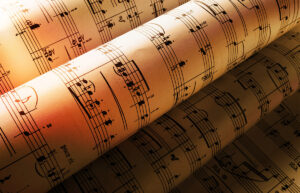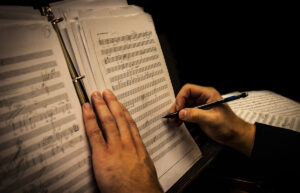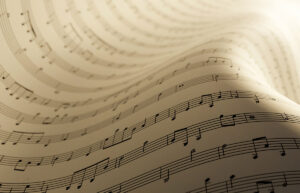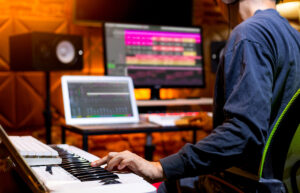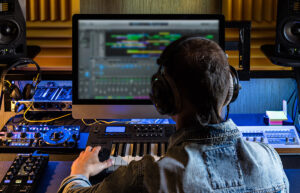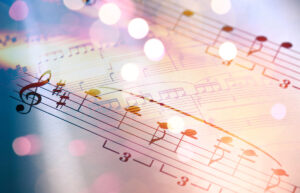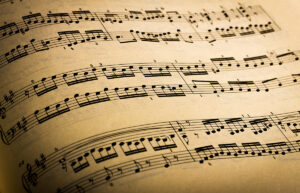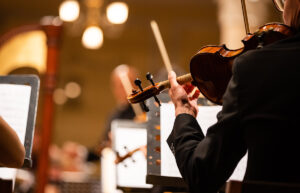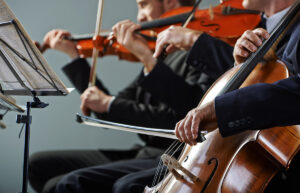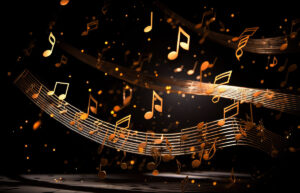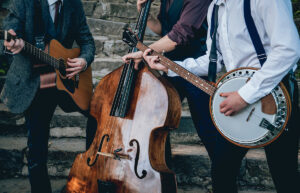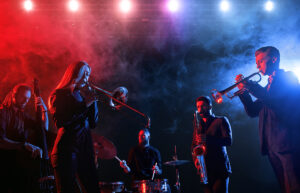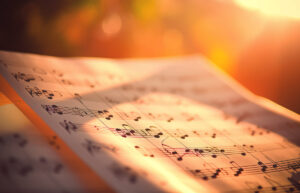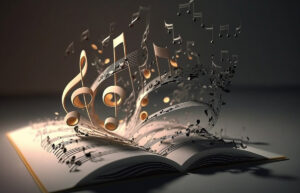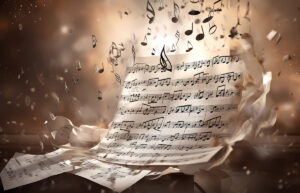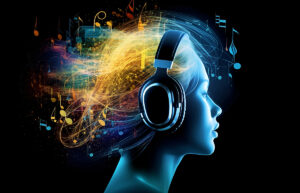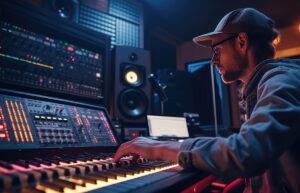Lo-Fi Music: A Genre for Relaxation and Productivity

Explore the enchanting world of lo-fi music. Discover how this genre enhances relaxation and productivity. Make the most of our guide on lo-fi music and zing to your daily life. Find out how the best lo-fi tracks improve your focus and serenity. You can listen to various subgenres of lo-fi and find the sound that whets your aural appetite. Listen to songs by noted artists listed in our guide. By the end of the blog, lo-fi is sure to become your favorite genre of music.
Welcome to TheDemoStop, now join the community!
Connect with artists, fans and producers around the world.
What is lo-fi?
Lo-fi, which stands for “low fidelity,” is a style of music known for its rough and unpolished sound. Lo-fi refers to the intentional use of imperfections, such as background noise, vinyl crackles, and soft melodies, to create a cozy and nostalgic atmosphere.
Thus, lo-fi music is meant to be played in the background while you study, work, or just relax. lo-fi is all about simplicity and coziness, providing a relaxing escape from the hectic pace of contemporary life. lo-fi’s music embraces imperfection, creating a peaceful and creative atmosphere.
History of lo-fi music
Lo-fi music first emerged in the 1950s and 1960s with Bob Dylan and The Velvet Underground’s raw, unpolished sound. With the rise of indie rock and the do-it-yourself (DIY) movement in the 1980s, this lo-fi approach became popular.
Medieval lo-fi beats combine medieval music’s beautiful melodies and harmonies with lo-fi production technology and became popular in the 2020s thanks to YouTube, Soundcloud, Apple Music, and Spotify. Medieval lo-fi beats have become popular as a unique blend of medieval music and lo-fi aesthetics.
2000s: High five to lo-fi
The origins of lo-fi can be traced to the early 2000s when visionary musicians such as Nujabes and DJ Shadow began experimenting with distinctive sound while attempting to create a definitive genre-bending music.
2010s: YouTube’s lo-fi explosion
The popularity of lo-fi increased in the 2010s because of the emergence of dedicated YouTube channels streaming the best lo-fi beats by innovative lo-fi artists. These channels introduced millions to the world of lo-fi music and introduced its calming, productive, and boosting qualities.
2020s: lo-fi goes mainstream
By the 2020s, lo-fi music had established itself as a mainstream genre of music. The influence of lo-fi was felt across various music genres, from commercials to popular radio. Lo-fi is characterized by its adaptability.
Characteristics of lofi music
Lo-fi music is characterized by the following:
Drum loops
Lo-fi music is known for its slow, repetitive drum loops, which form a rhythmic backbone, guiding listeners into a relaxed state of mind. In lo-fi music, drum loops frequently have a distinct vinyl crackle and warmth. Lo-fi gives an analog feel.The slow tempo of these loops makes them ideal for relaxing, studying, or just chilling. Lofi drum loops can be simple or complex, but they always provide a soothing and predictable rhythm that helps listeners focus.
Jazz chords
Jazz inspired chords added in harmony give lofi a unique layer of nostalgia and complexity.
Lofi music’s jazz-inspired chords add depth and emotion. Extended chords such as the seventh, ninth, and eleventh create a sophisticated and nostalgic harmonic palette. Lo-fi artists combine jazz chords with minimalist melodies or ambient sounds to create sophisticated yet relaxing music.These chords can be played on electric pianos, guitars, or synthesizers, giving lo-fi a jazzy feel while adding variety.
Samples
Lo-fi artists are expert samplers, frequently slicing up old records to evoke a sense of familiarity and melancholy. The expert use of samples extends beyond old records and may include film dialogue, nature sounds, or radio broadcasts. These samples tell a story or set a mood in the music. Lo-fi artists pitch shift, time stretch, and filter tracks to create a unique sound. Lo-fi musicians search for obscure and forgotten gems to add nostalgia, melancholy, or humor to their tracks, making sampling an art.
Key elements of lo-fi music
Key elements of lo-fi music often include elements the following elements:
Repeating drum beats
Lo-fi music has a steady rhythm of repeated drum beats that make people feel calm and relaxed. The repeating drum beats of Lo-fi frequently feature gentle, low-pass filtered kicks, and snares that create a soft and comforting pulse. The beats in this track were carefully designed to be background noise-free, making it easy for listeners to relax or focus. Lo-fi drum beats often have ghost notes and rhythms that are lightly swung. This gives the overall music a human touch that people can relate to. These hypnotic drum loops are relaxing and encourage creative and reflective thinking, making Lo-fi music a popular choice for studying, working, or relaxing after a long day.
Retro vibes
Lo-fi transports listeners to another era through vintage sounds and aesthetics. In addition to its sounds, Lo-fi music has a nostalgic visual style. Lo-fi album art and videos focus on complete sensory experience, which often feature vintage motifs, analog equipment, and references to past decades. Lo-fi artists are inspired by vintage anime, cassette tapes, and technology. The combination of retro vibes and contemporary elements creates a charming juxtaposition, making Lo-fi music more than just a throwback. Lo-fi is a bridge between the past and present, providing comfort to those who have lived through both the analog and digital eras.
Welcome to TheDemoStop, now join the community!
Connect with artists, fans and producers around the world.
Music sampling
Lo-fi tracks get more depth and personality when sampled from old records. Lo-fi music sampling involves finding vocal snippets, instrumental loops, and ambient sounds on old records. This infuses music with life and intrigue. Lo-fi producers often carefully blend these samples into their compositions. This blend of old and new elements gives the music depth and familiarity, making it emotionally engaging. Sampling in Lo-fi music allows the artist to weave a narrative or set a mood by recontextualizing and repurposing sounds from the past into a contemporary context, making it a dynamic and deeply expressive art form.
Chord progression
The unique jazz chords add a layer of sophistication to every note. Lo-fi jazz chords are often rich in harmonic texture, introducing lush seventh, ninth, and eleventh chords. These progressions make the music complex and serene. Lo-fi’s dreamy chord progressions evoke introspection and nostalgia. These chords work on electric pianos, guitars, and synthesizers. The harmonic structure in lo-fi adds musical depth and creates a relaxing, meditative soundscape.
Lo-fi music subgenres
Lo-fi music includes several subgenres, each with a distinct style. The following are some popular subgenres:
Lo-fi hip hop
This genre is perhaps the most popular subgenre, fusing the soothing aspects of lo-fi with the rhythmic beats of hip hop. Lo-fi hip hop is popular because of its soothing sounds and consistent presence on online streaming channels and radio. Lo-fi hip hop tracks are often mixed with relaxing visuals. This music is a favorite genre for relaxing, studying, and meditating. Many lo-fi hip hop songs use vocal samples from movies or spoken-word recordings to add nostalgia and storytelling. Dialog can be thought-provoking and whimsical. Lo-fi hip hop artists and fans interact on YouTube and Twitch, where live streams of lo-fi mixes create a sense of community.
Lo-fi jazz
This subgenre is heavily influenced by jazz and frequently uses live instruments that enthrall listeners. Live instrumentation, such as saxophones, trumpets, and upright bass, gives lo-fi jazz its spontaneity and emotion. Lo-fi jazz artists use solos and instrumental interplay to create unpredictability. Lo-fi aesthetics and jazz sensibilities create a timeless and contemporary subgenre perfect for listeners who revel in jazz’s sophistication and lo-fi’s laid back vibe.
Lo-fi house
Adding a dance groove to lo-fi by incorporating house music combines the infectious and danceable rhythms of house music with the serenity characteristic of lo-fi. The subgenre’s 4/4 beats and repetitive grooves make it perfect for home listening and underground clubbing. Lo-fi house artists use vintage synthesizers and drum machines to create a warm, analog sound. The music’s lo-fi aesthetics and electronic elements make it unique. For fans of electronic and lo-fi, the subgenre can go from living room listening to late-night dance floors.
Lo-fi synthwave
This subgenre combines the nostalgic sounds of Lo-fi with the retro futuristic sounds of synthwave in a fascinating way. Lo-fi synthwave combines synthwave’s evocative sounds with lo-fi’s calming and nostalgic qualities. Synthwave has dreamy atmospheres and retro-futuristic synthesizers.The subgenre takes listeners on a cybernetic journey through neon lights and 80s nostalgia. Lo-fi’s laid-back pace and synthwave’s energy create a soothing and exhilarating genre. The imagery of lo-fi synthwave often draws from 80s pop culture, science fiction, and cyberpunk, adding a visual dimension to the music that fans of both genres enjoy.
Lo-fi chillhop
As a fusion of chill and hip hop, lo-fi creates an ideal environment for laid back vibes.
Lo-fi chillhop blends chill and hip hop for a smooth mix of beats and rhymes. This subgenre creates a relaxing atmosphere perfect for introspection or casual socializing. Lo-fi chillhop artists often work with vocalists and rappers to create a dynamic mix of soothing instrumentals and engaging lyrics. This adds depth and variety to the subgenre. Soul, jazz, and R&B influence its music, making it rich and emotional. Lo-fi chillhop is lyrically engaging and melodically soothing because artists tell stories and express themselves.
Why is lo-fi music so popular
The relaxing and soothing nature of lo-fi is the primary reason for its popularity. The tranquility of lo-fi presents a perfect blend for studying, working, or just relaxing after a long day. Lo-fi music is an escape from today’s overstimulated and fast-paced world. Lo-fi appears to slow time and provide a sanctuary of calm appeals to people seeking daily peace and reflection. Lo-fi music is also well-known for its adaptability. Lo-fi works well for studying, working, relaxing, and even creative projects, making it a versatile soundtrack for life. Lo-fi’s simplicity makes it ideal music for reading, painting, or relaxing.
Lo-fi music and its impact on society
Lo-fi music is frequently used in therapeutic settings because of its calming effects, which provide comfort to people seeking relief from daily stress. What is lo-fi if not a haven for escape from the turmoil of the outside world? Lo-fi music is used in meditation and mindfulness as well as therapeutic settings. The ability of lo-fi to induce a state of relaxation and mindfulness aligns with the principles of mental and emotional well-being. Listeners and creators have formed a global community of lo-fi music on streaming platforms and social media. Lo-fi music, shared playlists, and live streams unite people worldwide. Lo-fi’s impact goes beyond music and has sparked visual art, animation, and a cultural appreciation for old and new, analog and digital, creating a unique synergy between arts and technology.
Welcome to TheDemoStop, now join the community!
Connect with artists, fans and producers around the world.
Why listen to lo-fi music?
Increased brain activity
Lo-fi’s soothing music has been shown to help people concentrate and focus.
Lofi music uses gentle, repetitive rhythms to induce deep concentration. Lo-fi helps people focus on studying, coding, and reading complex material. The brain stays relaxed and alert with lo-fi music, reducing distractions and improving cognitive engagement. A study revealed that Lo-fi music increases brain alpha wave activity, which promotes relaxed wakefulness, helping people stay focused and productive.
Improved cognitive ability
Listening to Lo-fi music boosts creativity and problem-solving skills. The calming and meditative qualities of lofi music stimulate creative thinking. Lo-fi inspires artists, writers, and designers by breaking creative blocks and freeing their thinking. Lo-fi music’s subtlety and emotional depth help with problem-solving and decision-making. Lo-fi provides a relaxing setting for mental exploration and introspection. Lo-fi’s mix of nostalgia and modernity fosters curiosity and creativity, making it a useful tool for brainstorming and art.
Elevated mood
The positive vibes of Lo-fi can lift your spirits. Positive and gentle lofi music uplifts the spirits of listeners. Comforting melodies and rhythms provide emotional security and well-being. Lo-fi’s mellow, nostalgic qualities evoke nostalgia and fond memories, which can lift one’s mood. Many people turn to Lo-fi music for comfort and positivity during emotional stress or improve their outlook on life.
Reduced anxiety
The calming effects of Lo-fi provide relief from stress and anxiety. The gentle nature of Lo-fi helps promote inner peace. Lo-fi’s steady rhythms help alleviate anxiety and panic attacks and help moderate emotions. Lo-fi tracks with natural sounds such as rain or water help reduce anxiety by calming and connecting listeners to nature.
Calming and restorative effects
Lo-fi’s soothing melodies heal the mind. Lo-fi music’s soothing melodies can help you relax after a long day or relieve stress. The gentle, repetitive nature of Lo-fi can relax the mind and rejuvenate it. Lo-fi is often used in meditation and deep relaxation exercises. Lo-fi music is soothing and suitable for sleep-deprived people. The relaxing bedtime atmosphere can help many people get a good night’s sleep.
Examples of Lo-fi music
The following are some popular Lo-fi music songs and albums:
Spiritual State

This album by Japanese producer Nujabes is a classic that captures the essence of Lo-fi music.
This classic album blends Lo-fi hip hop with jazz and soul. Listeners seeking a meditative Lo-fi experience will enjoy the album’s tranquil and introspective tracks. Because Nujabes masterfully blends jazzy chords, gentle drum patterns, and soulful vocal samples, Spiritual State is a timeless, ethereal, and emotional Lo-fi journey. Introspective and reflective, Spiritual State reminds listeners of Nujabes’ influence on Lo-fi and inspires artists and fans.
420 Everyday – Stay See

Stay See’s “420 Everyday” is a collection of soothing Lo-fi tracks ideal for relaxing. Each track embodies tranquility, making it ideal for stress-free listening. The compilation’s Lo-fi beats and warm, crackling vinyl sounds evoke the genre’s roots. 420 Everyday demonstrates the genre’s ability to create a calm and peaceful atmosphere, making it a popular background music for reflection.
One That Started it All

For people new to Lo-fi, the “The One That Started it All” is an eclectic mix and is an ode to the origins of Lo-fi music, which can be traced to early hip-hop instrumentals and ambient electronic compositions. Lo-fi’s roots are essentially captured in this collection of songs. Simple drum loops, smooth jazz chords, and understated melodies evoke nostalgia and relaxation. Early Lo-fi pioneers are the essence of this album. This compilation provides a captivating introduction to lo-fi’s origins, allowing for a deeper exploration of its diverse subgenres and contemporary expressions.
Yeah right

“Yeah Right” explores the heart of lo-fi music. This song is an excellent example of Lo-fi music’s emotional depth and storytelling. This lovely lo-fi recording conveys a range of emotions with mellow instrumentals and expressive melodies. The songs have vinyl crackles, soft guitar strums, and ethereal vocal samples to evoke melancholy and introspection. “Yeah Right” proves lo-fi can express deep and relatable emotions.”Yeah Right” shows how the genre can connect with listeners on a personal and emotional level, comforting them in times of solitude.
Day off – Softy

This is a great track for setting the tone for a relaxed day.”Day Off” by Softy is a lo-fi track perfect for chilling out. Its laid-back beats, dreamy melodies, and subtle instrumentation create a relaxing atmosphere for relaxing days. Softy’s “Day Off” embodies lo-fi chillhop, blending chill and hip hop elements for a laid-back vibe. This track shows that lo-fi music is perfect for relaxing and unwinding.
Somebody That I Used to Know (lo- fi cover)

This relaxed lo-fi cover of “Somebody That I Used To Know” is a gentle reinterpretation of the hit. The lo-fi treatment gives the song a nostalgic feel. The cover artist uses soft, muted instrumentals to create a mood that appeals to listeners preferring reflective music. “Somebody That I Used To Know (lo-fi cover)” shows how lo-fi can give popular songs a new perspective and emotional depth.
Welcome to TheDemoStop, now join the community!
Connect with artists, fans and producers around the world.
Lo-fi music artists
The following are popular lo-fi music artists:
Ocha
Ocha, one of the most promising young musicians of the lo-fi genre, known for producing hauntingly beautiful music that explores emotion. The ethereal melodies and evocative soundscapes appeal to listeners seeking a profound and reflective musical experience.Ocha’s atmospheric and contemplative tracks are well-known in the lo-fi community and demonstrate the genre’s ability to evoke strong emotions and introspection. Ocha’s calm, lo-fi music continues to captivate audiences with its dreamy and emotive compositions.
Nujabes
Nujabes is one of the genre’s earliest and most influential artists. As one of the first and most influential lo-fi musicians, Nujabes’ blend of jazz, hip-hop, and lo-fi left an indelible mark on the community. His timeless tracks remain a cornerstone of the genre. Complex yet soothing, Nujabes’ works feature intricate drum patterns, jazzy chords, and soulful vocal samples. Nujabe has inspired countless artists, and both newcomers and longtime fans continue to value them. Nujabes’ lo-fi music has comforted and inspired listeners worldwide.
Potsu
Potsu is a contemporary lo-fi artist who blends traditional and modern influences to create a unique sound that appeals to a wide audience. Potsu’s tracks combine nostalgia with modern production. People who want a seamless past-present transition ardently listen to Potsu. Potsu shows the lo-fi genre’s flexibility and ability to incorporate new elements while maintaining its soothing and introspective core.
Leavv
Leavv makes lo-fi beats that evoke strong emotions and introspection. The melodies are gentle and emotional, creating a contemplative atmosphere. Leavv’s soft instrumentals and organic sounds induce some calm for busy people. Leavv’s lo-fi music captures the emotional depth of the genre and connects with listeners on a personal level, providing a soundtrack for solitude and self-discovery.
Oatmello
An artist whose work depicts peace and reflection, exemplifying lo-fi meaning. Oatmello is an artist whose music explores peace and introspection, which is exactly what the lo-fi genre is all about. The compositions often feature soothing and meditative sounds, creating a serene ambiance for listeners. Listeners love Oatmello’s music for its calming, introspective vibe and find it as a music sanctuary for people to escape the daily grind and relax with soothing melodies and beats. Oatmello’s lo-fi contributions demonstrate the genre’s ability to provide mental and emotional healing through music.
Summary
Lo-fi is a musical genre that enhances productivity and relaxes the soul. We briefly summarize lo-fi music as follows:
What is lo-fi? Lo-Fi, which stands for “Low Fidelity,” is a style of music known for its rough and unpolished sound. Lo-fi essentially refers to the intentional use of imperfections, such as background noise, vinyl crackles, and soft melodies, to create a cozy and nostalgic atmosphere.
History of lo-fi music: Lo-fi first emerged in the 1950s and 1960s with the raw, unpolished sound of Bob Dylan and The Velvet Underground. With the rise of indie rock and the DIY movement in the 1980s, this lofi approach became even more popular. This captivating mix of medieval and lo-fi music is unique.
Medieval lo-fi beats became popular in the 2020s thanks to YouTube, Soundcloud, Apple Music, and Spotify.
- 2000s: High five to lofi
Visionary musicians such as Nujabes and DJ Shadow began experimenting with music to produce a distinctive sound while attempting to define the essence of lo-fi meaning.
- 2010s: YouTube’s lo-fi explosion
The rise in popularity in the 2010s was fueled in part by the emergence of dedicated YouTube channels streaming the best lo-fi beats by the best lo-fi artists.
- 2020s: lo-fi goes mainstream
By the 2020s, lo-fi music had established itself on the mainstream music scene.
Characteristics of lo-fi music: Lo-fi music is characterized by the following:
- Drum loops
- Jazz chords
- Samples
Key elements of lo-fi music: Key elements of lo-fi music often include the following elements:
- Repeating drum beats
- Retro vibes
- Music sampling
- Chord progression
Lo-fi music subgenres: Lo-fi music includes a lot of subgenres, each with its own style. Here are some popular ones.
- Lo-fi hip hop
- Lo-fi jazz
- Lo-fi house
- Lo-fi synthwave
- Lo-fi chillhop
Why is lo-fi music so popular? The relaxing and soothing nature of lo-fi is a primary reason for its popularity.
Lo-fi music and its impact on society: Lo-fi music is frequently used in therapeutic settings due to its calming effects to comfort people seeking relief from daily stress.
Why listen to lo-fi music? Benefits of listening to lo-fi music include:
- Increased brain activity
- Improved cognitive ability
- Elevated mood
- Reduced anxiety
- Calming and restorative effects
Examples of lo-fi music: The following are a few popular examples of popular lo-fi music:
- Spiritual State
- 420 Everyday – Stay See
- The One That Started it All
- Yeah Right
- Softy – day off
- Somebody That I Used To Know (Lofi Cover)
Lo-fi music artists: The following are a few popular lo-fi music artists.
- Ocha
- Nujabes
- Potsu
- Leavv
- Oatmello
FAQs
What is lo-fi music with lyrics called?
Lo-fi music with lyrics is called “Lo-fi hip hop” or “Lo-fi beats with lyrics.” This genre is a special fusion of relaxation and storytelling that is obtained by fusing the calming aspects of instrumental lo-fi with lyrical content.
Does lo-fi music actually help?
Yes, lo-fi music can be truly beneficial. Its soothing rhythms and melodies are known to reduce stress, improve concentration, and create a relaxing atmosphere making it a popular choice for relaxation and productivity.
What is the impact of lo-fi music?
Lofi music has a positive impact on mental well being, as well as stress reduction and improved concentration. Its relaxed atmosphere, infused with lofi meaning, fosters a calming and inspiring environment, enhancing relaxation and productivity.
Why did lo-fi become so popular?
Lofi’s popularity grew as a result of its ability to provide both relaxation and productivity. Its appeal was increased by the calming soundscapes and profound meaning that have made it a go-to option for melancholy professionals and people seeking solace.
How many lo-fi genres are there?
Lo-fi music has many subgenres, each with a distinct sound. Lo-fi subgenres such as lo-fi hip hop, jazz, house, synthwave, and chillhop add unique elements while maintaining the lo-fi meaning.
What age group listens to lo-fi?
Lo-fi music appeals to all ages. Lo-fi resonates strongly with younger generations, but it also captivates older listeners seeking relaxation and nostalgia, making the genre universally liked.
What is the difference between lo-fi and normal music?
Lofi intentionally uses imperfections such as background noise and vinyl crackles to create a cozy, nostalgic atmosphere, making it different from normal music. Lo-fi is rooted in simplicity, with a distinct, calming personality.
What are the characteristics of lo-fi music?
Lofi music is characterized by slow, repetitive drum loops, jazz influenced chord progressions, and the deft use of old record samples. These components produce a homey and nostalgic atmosphere that reflects the lofi meaning of warmth and simplicity.
Why is lo-fi music so popular?
Lo-fi music is popular because it provides a relaxing and productive atmosphere. The lo-fi meaning, mellow melodies, and accessibility have attracted a wide audience seeking peace and inspiration.
What are the benefits of listening to lo-fi music?
Lo-fi music improves focus, concentration, mood, anxiety, and calmness. Lo-fi emphasizes simplicity, creating a soothing and productive atmosphere.


